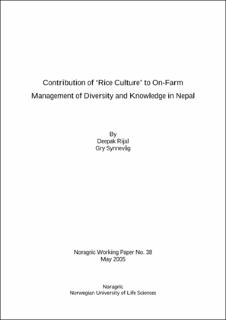| dc.contributor.author | Rijal, Deepak | |
| dc.contributor.author | Synnevåg, Gry | |
| dc.coverage.spatial | Nepal | en_US |
| dc.date.accessioned | 2020-09-30T12:28:58Z | |
| dc.date.available | 2020-09-30T12:28:58Z | |
| dc.date.issued | 2005 | |
| dc.identifier.issn | 0809-4934 | |
| dc.identifier.uri | https://hdl.handle.net/11250/2680548 | |
| dc.description.abstract | The paper analyses the ways ‘Nepalese rice culture’ contributes to maintaining crop landraces and knowledge. The paper discusses the importance of local practices relating to ‘rice culture’ as a case from three contrasting villages of Nepal. We discuss how farmers value landraces, describe ecosystems or niches and ways farmers respond if they interact. The links of this knowledge to livelihoods have been illustrated with examples. The importance is seen from a livelihood concept.
Farmers’ descriptions of “ecosystem” differ from one village to another. However, farmers across villages describe ecosystems using the same functional descriptors. The primary descriptor for ecosystems is soil moisture. Farmers characterise ecosystems further against soil colour, texture, scent and sometimes with soil acidity. Sometimes indicator species are also used. Unlike farmers’ ways of using larger descriptive units and scales, researchers describe ecosystems according to soil analysis data. The review shows that most of the landraces are grown under marginal and stressed environments. Improved varieties, however are grown with high level of inputs such as irrigation and fertilizers. But also some landraces are sometimes cultivated with inputs as improved varieties. Landraces are grown for generations by farmers for economical, ecological, social and religious reasons.
The paper recognises the important contribution of ‘rice culture’ to the conservation of crop landraces and local knowledge. Contributions are particularly important where farmers’ choices and services are limited. Unlike improved varieties, landraces combined with local knowledge, provide greater societal services. The paper concludes that landraces together with modern varieties contribute to peoples’ livelihoods. | en_US |
| dc.language.iso | eng | en_US |
| dc.publisher | Norwegian University of Life Sciences, Ås | en_US |
| dc.relation.ispartofseries | Noragric Working Paper;38 | |
| dc.rights | Attribution-NonCommercial-NoDerivatives 4.0 Internasjonal | * |
| dc.rights.uri | http://creativecommons.org/licenses/by-nc-nd/4.0/deed.no | * |
| dc.title | Contribution of ‘rice culture’ to on-farm management of diversity and knowledge in Nepal | en_US |
| dc.type | Working paper | en_US |
| dc.subject.nsi | VDP::Agriculture and fishery disciplines: 900::Agriculture disciplines: 910::Plant breeding, horticulture, plant protection, plant pathology: 911 | en_US |
| dc.source.pagenumber | 22 | en_US |

